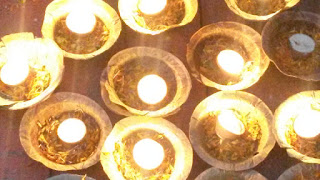Varanasi Part 2
JUNE 24, 2017
Enough with the gritty stuff. India is, obviously, much more than the occasionally evident poverty. Here are the fun things we encountered on our adventures through the holy city of Varanasi:
Chai continues to become a full-fledged addition, about which I have absolutely no regrets. We learned that chai is commonly sold in single-use clay cups. This was the traditional way of serving chai until paper/plastic disposable cups came along to ruin everything. So, why are these cups still used? A few reasons. (1) They make the chai taste better, adding an earthy taste that only unglazed terracotta can offer. (2) They’re more hygienic than washing and reusing cups -- they’re fired in a kiln and used by only one person. (3) They provide much-needed jobs. If you’re only using the cups once, someone has to keep making them. (4) They are (purportedly) more environmentally friendly than other disposable cups. When you’re done drinking from them, you throw the cups on the ground with a satisfying crash. They break into pieces and will eventually turn to dust, instead of littering the ground with ever growing piles of plastic and other non-biodegradable disposables. (I do question how long this habit is sustainable, though -- the clay has to come from somewhere and eventually it will be used up. They are, though, the lesser of two evils and are much more fun to drink from.
If you go to the right place, lassis are also served in these cups (though they’re much larger). Varanasi, apparently, is famous for its lassis. There is a tiny hole in the wall shop in the middle of the winding streets of the old city of Varanasi that serves some of the best lassis in northern India. There are 3 benches inside a closet-sized room with painted blue walls that are covered with hundreds of passport photos. On a ledge jutting out from the blue room sits a man, crosslegged, with a metal mortal and pessle, several small bowls of fruits and nuts and chocolate, and a giant dish of curd.
It is the kind of establishment in the kind of neighborhood that if you walked by unknowingly, you, as a cautious foreiger, would never dare sit in. But it is praised by every travel guide I have seen, and with good reason. The menu is extensive, the lassis mixed tediously by hand, and the taste is easily the best I’ve ever tasted (the fact that each lassi is served in those terracotta cups definitely makes them even better).
In addition to our culinary adventures, we were taken to a vendor of fine textiles. As Varanasi is India’s silk capital, our trip, seemingly be necessity, took us to see some of it. We sat on a cushioned floor in a room packed floor to ceiling with silk, pashmina, and cashmir. And we drank chai from terracotta cups as the owner explained to us how each of these textiles are made and how to tell if we are buying the real deal. The secret? Burn it. Silk, pashmina, cashmir, and wool will all smolder, turn to ash, and smell like burning hair. The fake stuff will burn like a candle. If you ever plan to go shopping for some expensive textiles, remember to bring a lighter with you, and be sketical of anyone who balks at the request to light a thread.
Varanasi being a spiritual city, we had to observe some of the spiritual rituals that take place. Oddly enough, despite the fact that the walkway along the Ganges is literally lined for miles on end with temples, we never went into to one. We did, however, spend an evening on a boat on the Ganges, where we offered votive candles and bowls of flowers to the river/goddess Ganges. An offering that has spiritual and religious meaning in Hinduism, but which our guide insisted was something you could do even if you weren’t Hindu. Not being Hindu, it was a little awkward. Also, touching the Ganges -- one of the world’s most polluted rivers -- was, shall we say, interestig. While I, and my fellow travelers, were loathe to touch the water itself (and scrubbed ourselves with hand sanitizer when we accidentally did), our guide dipped his hands into the river and ritually put the water across his face and neck.
Later that evening our boat, and about 200 others, gathered around the city’s main steps where two Hindu groups perform the Aarti ritual every evening. The religiosity is certainly there, but they’re also putting on a show as thousands of tourists sit on the water to look on and watch, as vendors climb from boat to boat selling chai and bowls of flowers and other touristy knick-knacks.








Comments
Post a Comment